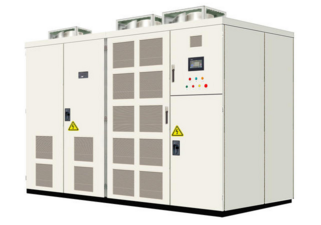服务于冶金、化工、电力、市政
建筑楼宇、工业制造及机械配套等工程项目
一、变频器主要原理基本知识

三相380V电网电压从变频器的L1, L2, L3输入端输入后,首先要经过变频器的整流桥整流,后经过电容的滤波,输出一大约530V左右的直流电压(这也就是我们常用来判断变频器整流部分好坏的最常测试点)。
当然整流桥最初是要经过断电测试的)然后经过逆变电路,通过控制逆变电路的通断来输出我们想要的合适频率的电压(变频器能变频最主要的就是控制逆变电路的关断来控制输出频率),变频器故障有无数种,好在现在变频器都趋于智能化,一般的故障它自己都能检测,并在控制面版上显示出其代码,用户只需查一下用户手册就能初步判断其故障原因。
但有时,变频器在运行中或启动时或加负载时,突然指示灯不亮,风扇不转,无输出。这时我们初学者就不知该怎办了。其实很简单的,我们只要把变频器的电源断了。断电测试一下它的整流部分与逆变部分,大多情况下就能知其故障所在了。
这里有一点千万要注意:
断电后不能马上测量,因变频器里有大电容存有几百伏的高压,一定要等上十几分钟再测!
▶ 变频器上电前整流桥及逆变电路的测试
具体测量方法如下:
找到变频器直流输出端的”+”与”-”,将万用表调到测量二极管档,黑表笔接”+”表笔分别接变频器的输入端L1, L2, L3端,整流桥的上半桥若是完好,万用表应显示0.3…的压降,若损坏则万用表显示”1”过量程。
相反将红表笔接”-”黑表笔分别接L1, L2, L3端应得到上述相同结果,若出现”1”则证明整流桥损坏。然后测试其逆变电路,方法如下:将万用表调到电阻×10档将黑表笔接”+”红表笔接变频器的输出端U, V, W应有几十欧的阻值,反向应该无穷大。反之将红表笔接到”-”重复上述过程,应得到同样结果。
这样经过测量在判断变频器的整流部分与逆变部分完好时,上电测量其直流输出端看是否有大约530V高压,注意有时万用表显示几十伏大家以为整流电路工作了,其实它并没工作,它正常工作会输出530V左右的高压,几十伏的电压是变频器内部感应出来的。若没530V左右高压这时往往是电源版有问题。
有的变频器就是由于电源版的一小贴片电阻被烧毁,导致电源板不工作,以致使变频器无显示无输出,风扇不转,指示灯不亮。 这样就可以初步判断出变频器是哪部分出现了故障,然后拆机维修时就可以重点测试怀疑故障部分。
二、技术基础
1、Electronic Line Shafting---ELS,许多工业生产线都由多台机器组成,各轴之间具有运动关系。过去是使用机械机构连接各轴,如果使用电子方式连接各轴,各州各有其驱动马达,则称为”Electronic Line Shafting”(ELS)。
2、 Auto Tuning(自动调校),常见于磁束向量型变频器的一种技术,能自动监测(找出)马达的参数,如转差频率/场电流/转矩电流/定子阻抗/转子阻抗/定子感抗/转子感抗等.有了这些参数后才能作[专据估算]及[转差(滑差)补偿].也因为此技术,在无编码器的运转下仍能获得良好的运转精度.
3、无编码器运转,在速度控制上,与旧式variable frenquency变频器的开回路比较,磁束向量型变频器内部由速度观测计算功能达成闭回路.马达侧不用装编码器也能达到良好的速度精度.无编码器运转有如下好处:
1),配线精省;
2),不必担心RF杂讯对编码器低电压信号的影响;
3),在多震动的场合不用担心编码器的高故障率。
4、变频器的矢量控制,在AC马达中,转子由定子绕组感应电流产生磁场.定子电流含两部分一部分影响磁场,另一部分影响马达输出转矩.要使用AC马达在需要速度与转矩控制的场合,必须能够把影响转矩的电流分离控制,而磁束矢量控制就能够分离这两部分进行独立控制.(具有大小及方向的物理量称为矢量)。
5、Field WeakeningField Weakening线路可用以减弱马达的场电流,改变与磁场的平衡关系,使马达高于基本转速运转。
6、定转矩应用,所需转矩大小不因速度而变的场合,常用到[定转矩应用].如传送带等负载.[定转矩应用]通常需要较大的起动转矩.[定转矩应用]在低速运转时易有马达发热问题,解决的方法:
(1)加大马达功率;
(2)使用装有定速冷却的变频器专用马达(即马达的冷却方式为强制风冷)。
7、变转矩应用多见于离心式负载,如泵/风机/风扇等,其使用变频器的目的一般为节能
比如当风扇以50%转速运转时,其所需转矩小于全速运转所需。可变转矩变频器能够仅给与马达所需转矩,达到节能效果。次应用中短暂的巅峰负载通常无需给与马达额外的能量。故变转矩变频器的过载能力可以适用于大部分用途。
定转矩变频器的过载(电流)能力须为额定值150%/1minute,而可变转矩变频器所需过载(电流)能力仅需额定值120%/1minute。因为离心式机械用途中很少会超出额定电流。另外,变转矩用途所需起动转矩也较定转矩用途小.。
8.变频器专用马达,所谓[Inverter-duty Motor]
主要特征如下:
1)分离式它力通风(它力风冷);
2)10Hz-60Hz为定转矩输出
3)高起动转矩
4)低噪音
5)马达装有编码器.*但并非所有称之为变频器专用马达的马达都具有上列特征。
9.关于调速
1)调速:根据工况需要调整设备运行速度,以达到节能降耗、减少磨损、按需生产等目的。
2)直流调速(DC Controler/motor):由直流控制器调节直流电机以达到调整速度的目的。
3)交流变频调速(AC inverter/motor):由变频器输出频率变化的三相交流电流从而控制交流电机的转速。
4)矢量变频调速(AC vector inverter):通过复杂的计算变换,使交流变频器按照直流电机的控制方式去控制交流电机,从而达到精确速度控制、转矩控制、提高输出扭矩等特性。
5)伺服控制系统(Servo control system):在运动系统中引入速度反馈或位置反馈元件,通过负反馈作用达到极其精密的速度控制、定位控制及高动态响应。
10.几个常见工业元件
1)测速发电机(Tacho-generator):一种转速测量元件,有交流、直流之分。
2)旋转变压器(Resolver):一种经济、准确地转速和角位移测量元件。
3)光电编码器(Encoder):一种精密的角位移、转速测量元件,适合在位置控制系统中作为反馈元件。
4)PLC:工业用计算、控制装置,实现逻辑、时序、计算等控制功能,一般作为整个自动化控制系统的上位主机。
5)HMI(Human-Machine Interface):人机界面。
6)现场总线(Field-Bus System):应用于工业控制现场的串行通讯总线系统,大幅度降低接线成本,提高控制的抗干扰能力。
7)分布式控制(Distributed control):区别于传统的集中式控制,强调各个节点设备的智能化,一般由现场总线系统将各子设备连接起来。极大地提高系统应用的灵活性、可靠性,降低上位机的运算负担。
11.关于电机的术语
1)防护等级(Protection Code):(IP**)考察一个设备防止异物进入和防水的能力,使IEC标准之一。其两个数字分别代表防异物和防水的能力,数值越高表明可以防止更细小的物体进入以及经受更强烈的水流冲击。一般为IP54(防尘,防泼洒水滴)以上防护等级的设备可以直接应用于露天。
2)绝缘等级(Insulation Grade):考察一个电气设备(一般针对电机)在保证良好绝缘特性的前提下所能承受的极限温升能力,是IEC标准之一。一般有B级(85度)、F级(105度)、H级(125度)。
Of course, the rectifier bridge will go through the power-off test at first) and then go through the inverter circuit to control the on-off of the inverter circuit to output the voltage of the appropriate frequency we want (the main thing that the inverter can convert frequency is to control the off of the inverter circuit to control the output frequency). There are numerous kinds of inverter faults, but now the inverter tends to be intelligent, and general faults can be detected by itself Test, and display its code on the control panel, the user only needs to check the user manual to preliminarily determine the cause of its failure.
But sometimes, when the frequency converter is running or starting or loading, suddenly the indicator light is not on, the fan does not turn, and there is no output. At this time, we beginners don't know what to do. In fact, it's very simple. We just need to turn off the power supply of the inverter. Power off test its rectifier part and inverter part. In most cases, you can know the fault.
Here's one thing to note:
After power failure, it can't be measured immediately, because there is a large capacitance in the frequency converter with hundreds of volts of high voltage, it must wait for more than ten minutes to measure!
▶ test of rectifier bridge and inverter circuit before power on of frequency converter
The specific measurement method is as follows:
Find "+" and "-" of the DC output terminal of the converter, adjust the multimeter to the measurement diode, connect the black probe with "+" probe to the input terminals L1, L2 and L3 of the converter respectively, if the upper half of the rectifier bridge is intact, the multimeter shall display 0.3 If it is damaged, the multimeter will display "1" over range.
On the contrary, connect the red lead and the black lead to L1, L2 and L3 respectively. The same result above shall be obtained. If "1" appears, it indicates that the rectifier bridge is damaged. Then test the inverter circuit, the method is as follows: adjust the multimeter to the resistance × 10, connect the black probe with "+" red probe to the output terminal u, V, w of the converter, which should have a resistance value of tens of ohms, and the reverse should be infinite. On the contrary, if you repeat the above process, you should get the same result.
In this way, when judging whether the rectifier part and inverter part of the converter are in good condition through measurement, power on and measure the DC output terminal to see if there is about 530v high voltage. Note that sometimes the multimeter shows dozens of volts. We think the rectifier circuit is working, but it is not working. It will output about 530v high voltage when it is working normally, and dozens of volts are induced from the inside of the converter. If there is no high voltage around 530v, it is often a problem with the power version.
Some frequency converters are due to the burning of a small chip resistance of the power version, which causes the power board to not work, so that the frequency converter has no display and output, the fan does not turn, and the indicator light does not light up. In this way, we can initially determine which part of the frequency converter has a fault, and then we can focus on testing the suspected part of the fault when disassembling the machine for maintenance.
2、 Technical basis
1. Electronic line shafting --- els, many industrial production lines are composed of multiple machines, and each axis has motion relationship. In the past, mechanical mechanisms were used to connect the shafts. If the shafts were connected electronically, each state had its own driving motor, it was called "electronic line shifting" (ELS).
2. Auto tuning is a technology commonly used in magnetic beam vector converter. It can automatically monitor (find) motor parameters, such as slip frequency / field current / torque current / stator impedance / rotor impedance / stator reactance / rotor reactance, etc. only with these parameters can we make [Special estimation] and [slip (slip) compensation]. Because of this technology, it can still be obtained without encoder Good running accuracy
3. In the speed control, compared with the open-loop of the old variable frequency converter, the closed-loop is achieved by the speed observation and calculation function in the magnetic beam vector converter. The motor side can achieve good speed accuracy without encoder. The operation without encoder has the following advantages:
1) , fine wiring;
2) , do not worry about the influence of RF noise on the low voltage signal of the encoder;
3) In the case of multi vibration, there is no need to worry about the high failure rate of the encoder.
4. In vector control of frequency converter, in AC motor, the rotor generates magnetic field by induced current of stator winding. Stator current includes two parts: one part influences magnetic field, the other part influences motor output torque. In order to use AC motor in the situation of speed and torque control, it is necessary to be able to separate the current that affects torque, and the magnetic beam vector control can separate the two parts independently Control. (the physical quantities with size and direction are called vectors).
5. The field peaking field peaking circuit can be used to weaken the field current of the motor, change the balance relationship with the magnetic field, and make the motor run at a speed higher than the basic speed.
6. Constant torque application, where the required torque does not change due to speed, is often used to [constant torque application]. For example, load such as conveyor belt. [constant torque application] usually requires a large starting torque. [constant torque application] is easy to have motor heating problem when running at low speed. Solution:
(1) Increase motor power;
(2) Use the inverter special motor equipped with constant speed cooling (that is, the cooling mode of the motor is forced air cooling).
7. Variable torque applications are commonly found in centrifugal loads, such as pumps / fans / fans, etc., whose purpose is generally to save energy
For example, when the fan is running at 50% speed, the required torque is less than that required for full speed operation. The variable torque converter can only give the required torque to the motor, achieving energy saving effect. Secondary application


